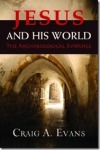 Craig A. Evans, Jesus and His World: The Archaeological Evidence (Louisville, KY: Westminster John Knox Press, 2012). $25.00, 208 pages.
Craig A. Evans, Jesus and His World: The Archaeological Evidence (Louisville, KY: Westminster John Knox Press, 2012). $25.00, 208 pages.
Craig A. Evans is Payzant Distinguished Professor of New Testament at Acadia Divinity College in Wolfville, Nova Scotia. He has written a number of books about Jesus and the New Testament at both scholarly and popular levels and appeared as a guest expert on a variety of television shows. “The goal of this book,” he writes in the Preface, “is to present what I regard as the most important archaeological discoveries pertaining to Jesus of Nazareth in a way that can be accessed by non-experts.”
The book contains and Introduction, five chapters and two appendices. The Introduction notes that “what archaeologists uncover is not so much proof as clarification.” In terms of biblical archaeology, this means that archaeology sometimes makes a direct “correlation” between the text of the New Testament and its finds. Generally, however, what if finds works more indirectly, showing that New Testament accounts have “verisimilitude” or “resemblances to the truth.” Correlation proves; versimilitude clarifies.
Chapter 1 reviews the archaeological evidence about Jesus’ hometown, Nazareth. The Jesus Seminar generally and John Dominic Crossan particularly have argued that the New Testament Gospels misrepresent the historical Jesus. Instead of a Jewish Messiah and miracle worker, they conclude that Jesus was a “cynic sage.” For this interpretation to work, Jesus’ home life could not have been devout, and he must have been exposed to a significant Gentile presence. Unfortunately, archaeological digs in both Nazareth and Sepphoris (the nearest large city to Nazareth) make this significant Gentile presence. Both the village and the city were inhabited by Torah-observant Jews. This coheres with the Gospel portrait of Jesus himself as a Torah-observant Jew.
Chapter 2 counters the argument, made by Howard Clark Kee in the late 1990s, that synagogues arose in the aftermath of the destruction of the Jerusalem temple in A.D. 70. This entails that Gospel narratives involving Jesus participating in synagogue rituals are post-hoc additions to the text, not genuine historical memories. Evans culls both literary evidence (from Josephus and Philo) and archaeological evidence from digs in the Holy Land to prove the existence of synagogues well before the fall of Jerusalem. He also shows how what evidence there is coheres with the notion of the synagogue as a place where, among other things, Jews gathered to worship God, study Scripture, and pray.
Chapter 3 surveys the available evidence on literacy in the ancient world and Roman Palestine to conclude that Jesus most likely was literate. He concludes, “The sudden emergence of a prolific literary tradition from an illiterate founder is not impossible of course, but it is less difficult to explain if Jesus were in fact literate.”
Chapter 4 places Jesus’ conflicts with the established religious leaders in Jerusalem in its historical context. Warning signs from the Second Temple period have been discovered that help explain Jesus’ anger at the aristocratic priesthood which made it difficult for Gentiles to worship God at “the house of prayer for all nations.” Moreover, archaeological digs in Jerusalem have uncovered the houses of the ruling elite, which were often large and well furnished, in comparison to those of the general populace.
Chapter 5 looks at “Jewish burial traditions” in the pre-A.D. 70 period. He shows how these widespread burial practices cohere with the Gospel accounts of Jesus’ death and burial. Specifically, he counters the notion that the Romans never allowed the bodies of crucified persons to be buried by their family or friends. This lends verisimilitude to the Gospel accounts of Jesus’ burial in a tomb known to his disciples and calls into the question that Jesus’ body was thrown into a shallow, unmarked grave or left out to rot.
Appendix 1 refutes the contention of Simcha Jacobovici, Charles Pellegrino, and James Cameron that Jesus’ family tomb (and perhaps his own ossuary) has been found in East Talpiot. Appendix 2 speculates on what Jesus may have looked like. “Jesus probably looked like most 30-year-old Jewish men in the first century,” he concludes, “and we have a pretty good idea of how they looked,” based on scientific reconstructions of facial characteristics from a skull as well as from Egyptian mummy portraits of the period.
On the whole, I found Evans’s account to be reasonable, well-researched, and clearly written. There are no “bombshell” revelations in this book, but rather the patient reporting of decades of archaeological scholarship. Far from debunking the accounts of Jesus’ life in the Gospels, this scholarship adds verisimilitude to their portraits, even correlation where discoveries warrant it.
P.S. If you found this review helpful, please vote “Yes” on my Amazon.com review page.

